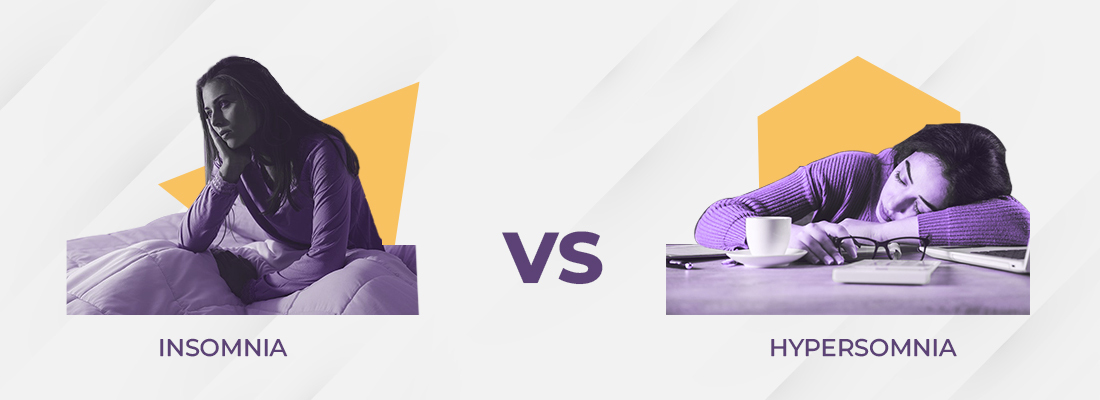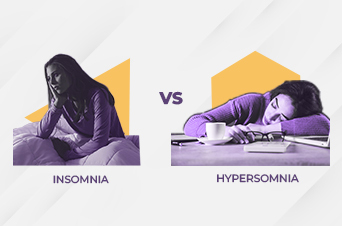
Sleep is an essential component of human life, and it is often taken for granted until disrupted by disorders such as insomnia and hypersomnia. Insomnia vs Hypersomnia are conditions that represent opposite ends of the spectrum of sleep disturbances. However, they share the ability to significantly impact an individual’s quality of life and overall health.
While one is characterized by difficulty falling or staying asleep, the other involves excessive daytime sleepiness. These conditions not only affect an individual’s quality of life but also have significant implications for their health and well-being.
Understanding the intricacies of insomnia vs hypersomnia is crucial for accurate diagnosis, and effective treatment. This blog will investigate the details of both the conditions and help you acquire good sleep hygiene to manage them.
What is Insomnia?
Insomnia, derived from the Latin word “in” (meaning “not”) and “somnus” (meaning “sleep”). It is a condition marked by persistent difficulty falling asleep, staying asleep, or experiencing non-restorative sleep despite adequate opportunity for sleep. Individuals with insomnia often report feeling dissatisfied with their sleep.
According to the National Council of Aging, approximately 30% of adults exhibit symptoms indicative of insomnia. Among them, about 10% experience insomnia severe enough to disrupt their daytime functioning. Insomnia presents in varying durations, ranging from transient episodes lasting for a few nights to chronic conditions persisting for months or even years. Moreover, these statistics underscore the prevalence and potential severity of insomnia, highlighting the need for effective intervention and management strategies.
See Also: Is Insomnia Hereditary? What The Research Shows
Causes of Insomnia
Insomnia, often multifaceted in its origins, can arise from a combination of psychological, physiological, and environmental factors. Understanding these causes and finding the triggers is essential to managing insomnia.
Also Read: VA Disability Ratings and Benefits for Insomnia
Psychological Factors
Psychological factors such as stress, anxiety, and depression play significant roles in the development and perpetuation of insomnia. Stressful life events, work-related pressures, or personal conflicts can trigger heightened arousal and cognitive rumination. It makes it difficult for individuals to unwind and fall asleep.
Anxiety disorders, characterized by excessive worry and apprehension, can exacerbate bedtime fears and disrupt sleep continuity. Similarly, depression, with its associated symptoms of low mood, loss of interest, and disrupted circadian rhythms. It can often manifest as insomnia
Physiological Factors
Chronic pain and medical conditions represent significant physiological contributors to insomnia. Individuals suffering from conditions such as arthritis, fibromyalgia, or neuropathy often experience persistent discomfort or pain that interferes with sleep onset and maintenance.
Moreover, certain medical conditions, including respiratory disorders like asthma or obstructive sleep apnea, neurological disorders such as Parkinson’s disease or restless leg syndrome, and endocrine disorders like hyperthyroidism, can disrupt sleep architecture and contribute to insomnia symptoms.
Environmental Factors
Environmental factors encompass a range of influences that can adversely affect sleep hygiene and contribute to insomnia. Poor sleep habits can disrupt the body’s natural circadian rhythms and can impair sleep quality.
Additionally, environmental stressors such as noise pollution, excessive light exposure, uncomfortable sleep environments, or uncomfortable bedding can hinder the transition to restful sleep. Modern lifestyles characterized by excessive screen time and electronic device usage before bedtime can further compound these environmental challenges. This disrupts melatonin production and delays sleep onset.
What is Hypersomnia?
Hypersomnia, characterized by excessive daytime sleepiness despite sufficient nighttime rest, affects 4% to 6% of the population, with a higher prevalence in men due to sleep apnea syndromes. Those with hypersomnia struggle to stay alert during the day, often experiencing irresistible urges to nap or sleep at inappropriate times.
Unlike fatigue, which can stem from various sources, hypersomnia is distinguished by its distinct symptom of excessive sleepiness and difficulty in sustaining wakefulness.
Furthermore, comparing Narcolepsy with Hypersomnia: Signs, Causes, and Treatments
Causes of Hypersomnia
Hypersomnia can be primary, where it occurs independently, or secondary, where it manifests as a symptom of an underlying medical or psychiatric condition.
Primary Hypersomnia
Primary hypersomnia disorders encompass conditions where excessive daytime sleepiness occurs without an identifiable cause. Narcolepsy is one such disorder, characterized by sudden and uncontrollable episodes of sleep. It is often accompanied by symptoms like cataplexy (sudden loss of muscle tone), sleep paralysis, and vivid hallucinations upon falling asleep or waking up. Another primary hypersomnia disorder is idiopathic hypersomnia, which involves excessive daytime sleepiness without the characteristic symptoms of narcolepsy.
Secondary Hypersomnia
In contrast, secondary hypersomnia arises as a symptom of underlying medical or psychiatric conditions. One common cause is obstructive sleep apnea, which leads to disruptions in breathing and frequent awakenings throughout the night. Some medications, such as certain antidepressants, antihistamines, and sedatives, can also induce excessive daytime sleepiness. Additionally, neurological disorders such as Parkinson’s disease, multiple sclerosis, or brain injuries may disrupt the brain’s regulation of sleep and wakefulness.
Insomnia vs Hypersomnia
While the debate of insomnia vs hypersomnia may seem like opposites, they can sometimes coexist within the same individual or emerge sequentially over time chronic insomnia may lead to sleep deprivation, causing daytime sleepiness. Conversely, hypersomnia’s excessive daytime sleepiness can disrupt the ability to maintain a regular sleep schedule, contributing to difficulties falling asleep or staying asleep at night. This cyclical pattern of sleep disturbances can further exacerbate overall sleep dysfunction.
Furthermore, chronic insomnia characterized by persistent sleep difficulties can lead to sleep deprivation and subsequent daytime fatigue and sleepiness. This daytime sleepiness may prompt individuals to take naps or rely on stimulants like caffeine to stay awake during the day. However, these interventions can further disrupt nighttime sleep patterns, perpetuating the cycle of insomnia. Conversely, excessive daytime sleepiness resulting from hypersomnia can impair daytime functioning and productivity, leading to increased stress and anxiety. This shows that insomnia vs Hypersomnia is more connected than it may seem.
Can you have insomnia and hypersomnia?
Yes, individuals can experience both hypersomnia and insomnia simultaneously, although rare. They may struggle with difficulty sleeping at night (insomnia) while also experiencing excessive daytime sleepiness and irresistible urges to nap during the day (hypersomnia). This coexistence can significantly impact quality of life, leading to disruptions in both nighttime sleep and daytime functioning.
Treatment Options
Treatment strategies for insomnia vs hypersomnia vary depending on the underlying causes and individual needs. For insomnia, healthcare providers often consider cognitive-behavioral therapy (CBT) as the first-line approach, which focuses on addressing maladaptive thoughts and behaviors contributing to sleep disturbances. Additionally, they may prescribe sleep hygiene practices, relaxation techniques, and, in some cases, medication to improve sleep quality.
In contrast, managing hypersomnia typically involves identifying and treating any underlying medical or psychiatric conditions contributing to excessive daytime sleepiness. Stimulant medications, such as modafinil or methylphenidate, may be prescribed to promote wakefulness during the day. Lifestyle modifications, including regular exercise, consistent sleep schedules, and avoiding alcohol and caffeine, can also help alleviate symptoms of hypersomnia.
The Importance of Sleep Hygiene
A good way to manage insomnia vs hypersomnia is cultivating good sleep hygiene. It involves maintaining a consistent sleep schedule, creating a conducive sleep environment, limiting electronic device exposure before bedtime, and practicing relaxation techniques. Prioritizing sleep hygiene and seeking medical intervention, when necessary, can help individuals achieve a healthier sleep balance
Sleep it Away
In conclusion, while the debate insomnia vs hypersomnia may persist, it’s essential to recognize that both conditions represent unique challenges in the realm of sleep disorders. Instead of viewing them as opposing ends of a spectrum, it’s more productive to understand them together. For those grappling with the question can you have insomnia and hypersomnia, it is important to relax and incorporate relaxation techniques and improve sleep hygiene
Ultimately, rather than viewing insomnia vs hypersomnia as adversaries, approaching them with a sense of compassion and understanding is key. Remember, there is no one-size-fits-all solution, and it may take time and patience to find what works best for everyone. By prioritizing self-care and seeking support when needed sleep, individuals can work towards achieving a healthier balance and enjoying restful slumber.

